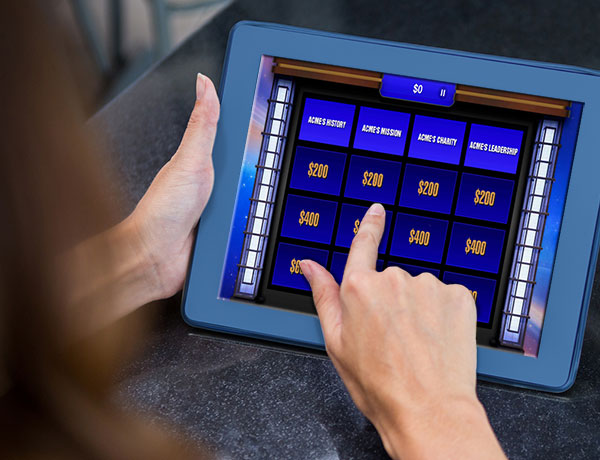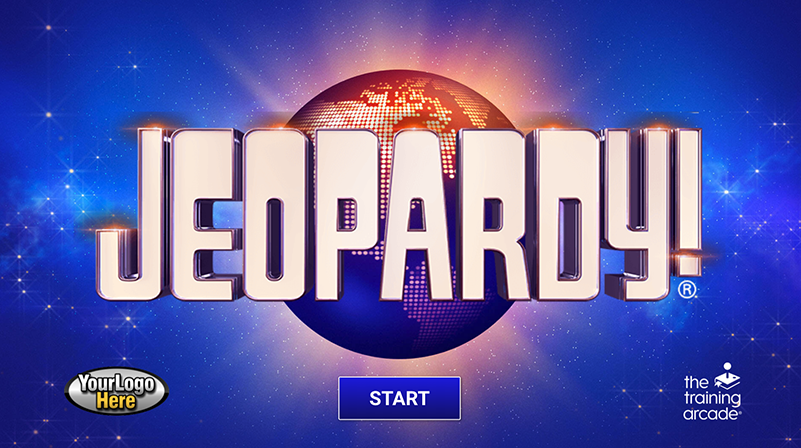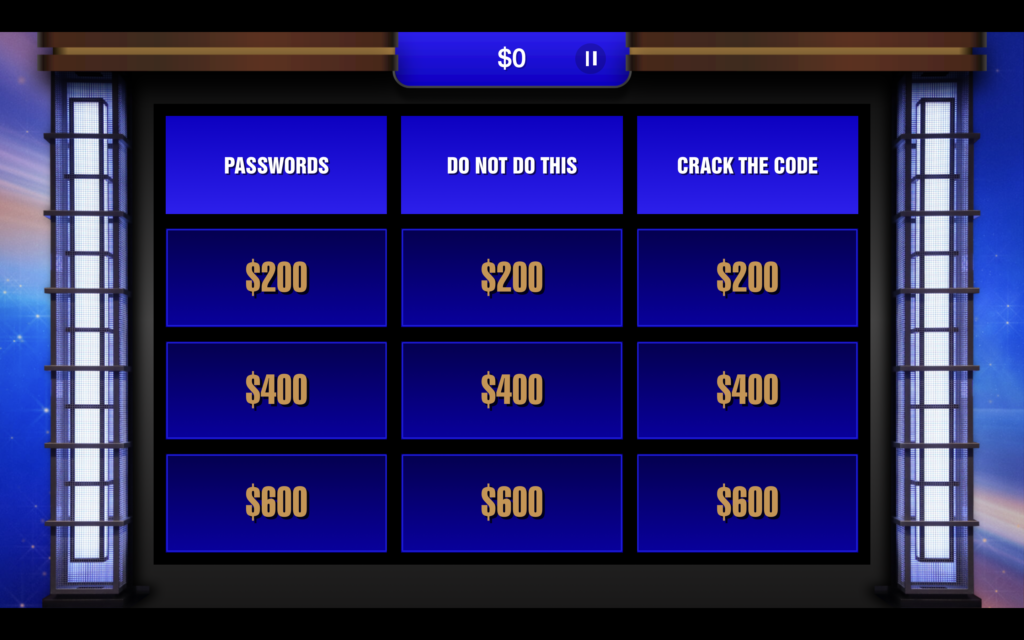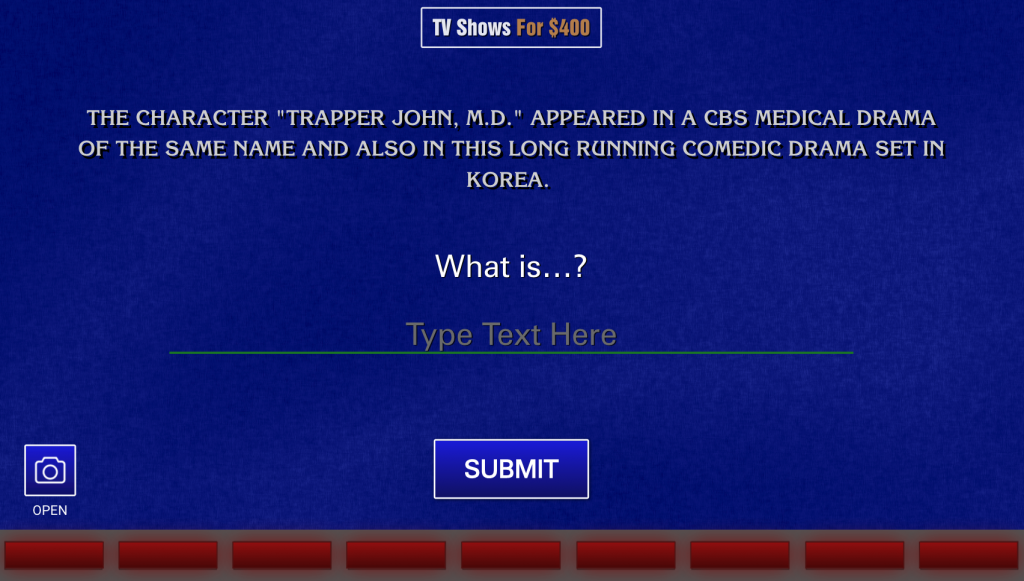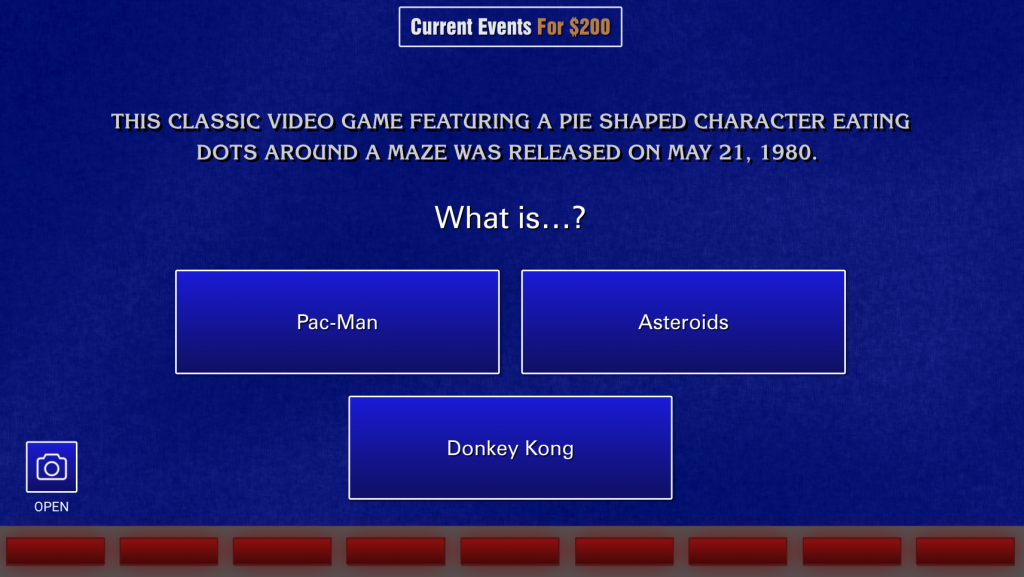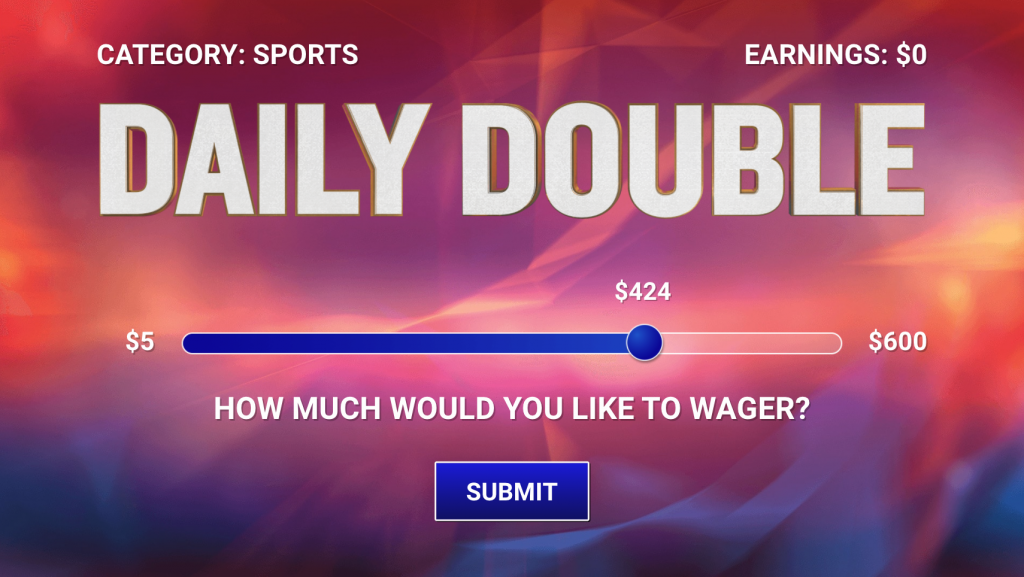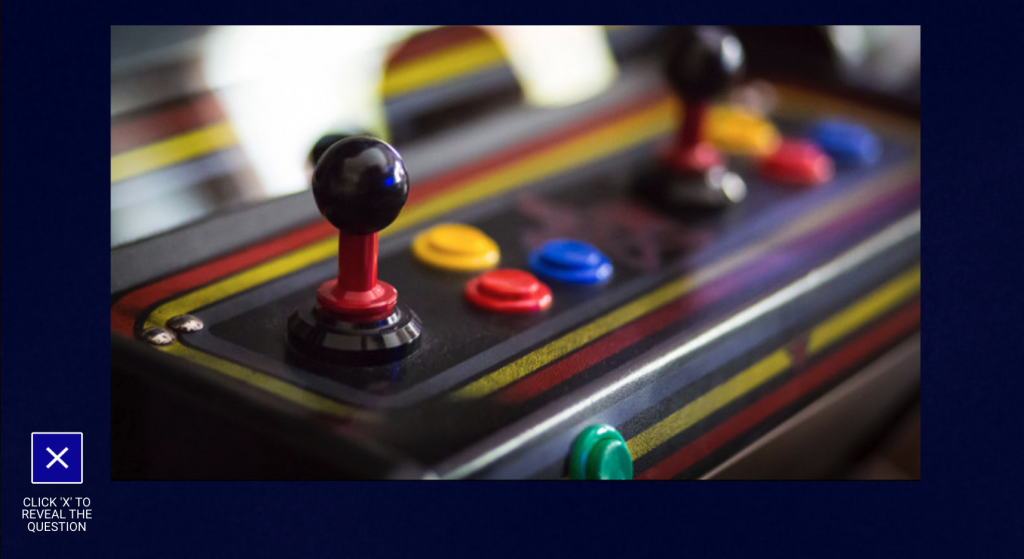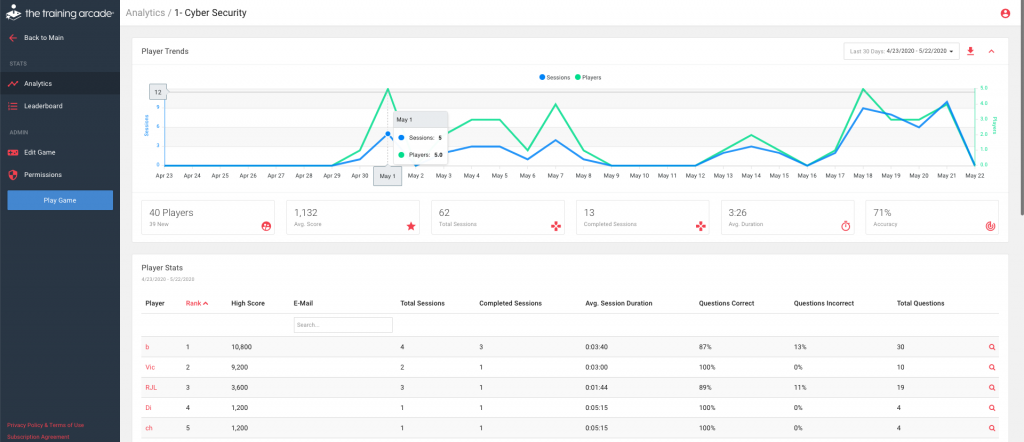By Managing Partner, Richard J. Lowenthal
The Training Arcade®, DIY game authoring tool, makes creating and launching your JEOPARDY!® learning game fast and easy using our pre-built JEOPARDY! template.
But, where do you start? Well, The Training Arcade has done all the heavy lifting of creating the game mechanic, gorgeous art, backend database, hosting infrastructure, and security system, so, you can focus on the content.
And, here’s a handy template to organize your content for your JEOPARDY!® game for training.
Below are 5 tips to help you create a JEOPARDY!® learning game that is engaging, entertaining, and educational. We refer to this as the “3 Es”.
1. Create Specific Categories and Clues That are ‘Just Right’
JEOPARDY! co-head writer Billy Wisse offers the following advice in an article he contributed to Popular Mechanics a couple of years back, “a good JEOPARDY! clue has to elicit one of three reactions: ‘I knew that,’ or ‘darn I should have known that,’ or ‘I didn’t know that, but now I’m glad I do.’”
In gamifying Billy’s advice for training and education, we recommend first getting a little philosophical. Imagine yourself sitting across from the employee who played your JEOPARDY! game and walking through their results clue by clue. How is each clue directly related to the skills needed to do their job? What corrective action would you take if that person responded to a clue incorrectly? What additional training would you provide them? What would it tell you about the employee when they provide a correct response?
Correlate the very specific information and skills an employee needs to the specifics of the course and content to which the JEOPARDY! game corresponds. In so doing, you will be able to construct a meaningful JEOPARDY! game for them. In essence, work backwards from the performance outcome you are looking to achieve the specific clues.
Let’s now go from the esoteric strategic down to the tactical. How many clues should you have in your game? Well, and you knew this answer was coming … it depends.
It depends on the role the game is playing in your educational campaign. If it’s meant to serve as both the delivery mechanism for the content and the assessment of knowledge, you’ll want more clues. The maximum number of clues in The Training Arcade JEOPARDY! game is 51 = 5 categories by 5 rows in the JEOPARDY! round + 5 x 5 in Double JEOPARDY! + 1 Final JEOPARDY! clue.
You’re probably thinking to yourself, well how much time does it take for a person to play 51 clues? Yup, here it comes again, well, it depends. If the content is well known to a player and the game is being played in single-player mode, you’re probably looking at 45 seconds per clue. With Online Group Play™ (OGP™), a feature that helps you play JEOPARDY! live on a Zoom call, each clue takes about 2 minutes since the host narrates and there’s usually some playful banter between players.
On the flip side, you can create a JEOPARDY! game that consists of as few as ten clues total = 3 x 3 in the JEOPARDY! round + no Double JEOPARDY! + 1 Final JEOPARDY! clue. In so doing, you could potentially have a single-player JEOPARDY! game that takes the player about eight minutes to complete.
The number of clues then will depend on the purpose of the game, the amount of content you are looking to gamify, the game delivery (single player or OGP™), and the time you wish to have your audience invest in the training.
Once you determine the number of clues, it’s time to get out the old quill and ink. As you write the clues, place them into the categories which will be the column headings for your game. The categories will shape the player’s thought process and create organic associations. The more logical the connections between the clues in a category, the tighter the associations will be in the player’s brain, and the easier it will be for them to retrieve when needed.
I’m a big fan of drafting the clues in a spreadsheet as it helps me organize my thinking. I have one spreadsheet column for the clues and the second for the categories in which they fall. I don’t bother writing possible responses for the clues until after I’ve determined the right balance of clues between categories.
Others on our team prefer to create a list of the responses you’d like to see from your players based on your material, drafting clues to match those desired responses, and finally placing them into appropriate categories.
Whichever approach you take, creating a JEOPARDY! game is a fun and creative exercise, and juggling the content to fit the desired number of rows and columns is a bit like playing Tetris.
Let’s head further down the rabbit hole of tactical elements for making a JEOPARDY! game. When naming the categories, we provide you a maximum of 30 characters for each category header and 295 characters for each clue. I’m a fan of brevity to add a bit of mystery and whimsey. It’s actually harder and requires more creativity to keep the category headers and clues short.
And, here’s a fun conundrum to keep in mind. Since each person will play your JEOPARDY! training game in the order of their choosing, make sure to not inadvertently give away an answer to a particular clue through a related clue in a different category.
Important note on game strategy: have each row of clues get progressively more difficult and have the clues in Double JEOPARDY! be more difficult than the JEOPARDY! round. Suffice it to say, Final JEOPARDY! should be the most difficult clue in the game.
The level of difficulty for a clue can be based on the content of the clue, its obscurity, and the type of response available to the player, as you’ll soon see in hint #2.
Enid Crystal, Instructional Designer shares her thoughts on creating good clues: “When designing your game, it’s helpful to keep two questions in mind: what knowledge do you want the player to walk away with and what will the player experience be during the game. You want to hit the sweet spot when providing clues and response choices. Like Goldilocks and the three bears, your clues and response should not be too easy, not too difficult, but just right. Cleverly written clues can help inject fun and challenge into your game. Word your clues to be playful and intriguing; providing enough – but not too much- information to spark the player’s curiosity and imagination.”
2. Challenge Your Learners with Meaningful Multiple Choices and Text Input and Guide Them with Feedback
After you have created your clue, determine the phrase to begin the correct response (eg. What is? What are? Who is? Who are? etc.). Then create the responses. The Training Arcade® gives you the option to create responses to your clues in the form of multiple-choice or text input. When creating a text input response, you have the option to include up to 50 variations of acceptable responses per clue.
Deciding which response type, multiple-choice, or text input, is part of the art form of game creation. Multiple-choice responses (2 to 4) can be easier for the player than the blank [Type Response Here], but it’s not a given because the level of difficulty depends on the clue and context. We recommend mixing things up between the response types to keep the players on their toes.
When writing your multiple-choice response, make the choices meaningful. As with other aspects of creating a game, writing multiple response choices is a balancing act. “Avoid choices that are tricky”, says Paul Wilson, Instructional Designer, and Adobe Captivate Expert. “They don’t help people learn. Make sure all your answers are plausible. So often developers will put in answers that are obviously distractors that the interaction isn’t challenging and even juvenile.”
Non-plausible responses break the wall of suspension of disbelief needed for creating the most emotionally interesting entertainment and must be avoided.
With your fabulous categories, clues, and responses written, you’ll next turn your attention to corrective feedback. While not required, providing feedback to a player when their brains are open to contextually relevant information is critical. Seize the moment to course correct when the player has responded incorrectly and to provide additional information to the player who responded correctly. You are never required to have feedback for a clue but we certainly suggest adding as appropriate.
With so many of our subscribers to The Training Arcade using their games as part of ongoing professional education, we added an even deeper level of feedback, aptly called Advanced Feedback. For those clues you deem worthy of a lot more information, you can add an unlimited number of slides that appear after a player has responded to a clue.
3. Create a Healthy Sense of Urgency
In the television show, Alex Trebek gives the contestants 5 seconds to respond to a clue. While 5 seconds makes for great TV, it’s probably too short for an employee to respond to course-related queries. We’ve found 30 seconds works well for the single-player mode, though if your content is complicated or if the response type is Text Input, you may want to wish to increase the time to 45 seconds. Don’t make the timer too long, as it can slow the pace of the game.
At the outset of creating a game, you will be set a default timer for each clue in the game. When creating each clue, you will have the opportunity to override that default.
For JEOPARDY! games played in the Online Group Play mode, we recommend shortening the time for each clue to create a higher degree of urgency and to keep the game moving along at a brisk, fun pace.
An additional note about the OGP mode: if you wish to increase the game excitement and motivate engagement by all, you can penalize players for not responding to a clue. Or, you may choose to match the gameplay mechanic on the TV show, if a player does not respond to a clue, they would not be penalized for not responding. Not penalizing a player for a not responding minimizes guessing. If you prefer to not have players guess if they don’t have a clue (pun intended), toggle <Allow No Response> to YES in the Game Info tab. Yes, I know, lots of double-negatives.
4. Don’t Forget Double JEOPARDY! and Final JEOPARDY!
As indicated earlier, Double JEOPARDY! is an optional round and great addition to your JEOPARDY! game. This second round of gameplay allows the learner to wager more money and compete even further to climb the ranks of the leaderboard.
Unlike Double JEOPARDY!, Final JEOPARDY! is a required clue round and should be the most difficult one in the game. To replicate the feel of the TV show, you may wish to consider having its response be Text Input.
Technical note: a player must have at least $1 to wager and play Final JEOPARDY!. If they do not have at least $1, they will be able to play along in “fun mode” but their response will not impact their score or standing on the leaderboard.
5. Make the Game More Engaging with Images and Videos
Because people have different learning styles (visual, auditory, reading, writing, and kinesthetics) and use these modalities in varying degrees on the job, we felt it critical to enable you to employ the spectrum of communication styles in creating a game.
You can craft your clues and even Advanced Feedback with text, images, and even videos!
Technical note: the image ratio for images and videos needs to be standard 16:9, and we recommend keeping the image file size less than 1 MB and videos to less than 30 seconds to keep the pace of the game moving forward. Keeping videos to short snippets is especially important for Virtual Instructor-Led Training conducted with large groups.
Adding images and videos will not only help educate but will up the level of engagement, entertainment, and fun!
Launch and Play Your JEOPARDY! Online Game
The best advice my mother gave me, well at least as related to computers, was to save my work, often. It’s no different with JEOPARDY! or any other game in The Training Arcade. In JEOPARDY!, we provided a <Save Draft> feature which will enable you to do so save your game even if you haven’t created all the clues in your game.
Once your game is created, you have a bevy of options for sharing it with your employees to play. Click here to learn about all publishing modes. In summary, you can copy the link and share it via email, text, or chat window; embed the game into an iFrame on your website; embed the game as a web object into a course you create using your preferred authoring tools, such as Captivate, Storyline or Lectora or PowerPoint presentation; or embed the SCORM manifest into your LMS.
When you’re ready to go big-time, play game show host with your very own multiplayer Online Group Play JEOPARDY! Game. Run your virtual quiz show by placing your JEOPARDY! game into Virtual Instructor Led mode and copying the game link into the chat window of any of the popular web conferring tools such as Microsoft Teams Skype, WebEx, Google Meet, or BlueJeans.
Analyze The Results
The games in The Training Arcade have two sides to one coin: one side is driving deeper learning through the power of play, and the other is mining the data from the player engagement. The Training Arcade analytics dashboard is engineered to unveil patterns of individual and group engagement with your educational material. Understanding the results of the player training is a key to identifying knowledge gaps, course-correcting at the individual and group levels, and through iteration, ensuring your training program delivers a healthy return on investment. Tactically, in the analytics dashboard, you will be able to quickly see the number of users, scores, rank, sessions, session duration, % of clues correct/incorrect, total clues answered, specific right or wrong, and time to respond to each clue. You can sort the data, select reporting periods, and export the data for integration with your other systems. Because you can only achieve what you measure, we want to help to ensure you have all the data to achieve success.
It’s Really That Easy
In creating the JEOPARDY! game, our goal was to dazzle your employees with the authenticity of the TV show and immerse them intellectually and emotionally in your content. Equally important was to make the creation of clues, responses, and feedback as straightforward and fast as possible. We wanted to release your creativity and alleviate all technical considerations as you transform the training experience into a positive and memorable one. Play a JEOPARDY! sample game here. Start your free 14-day trial today and let us know how we did.

